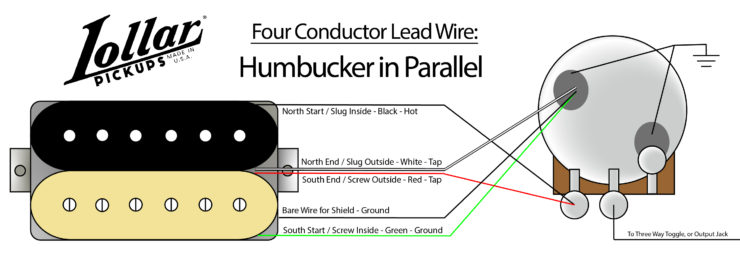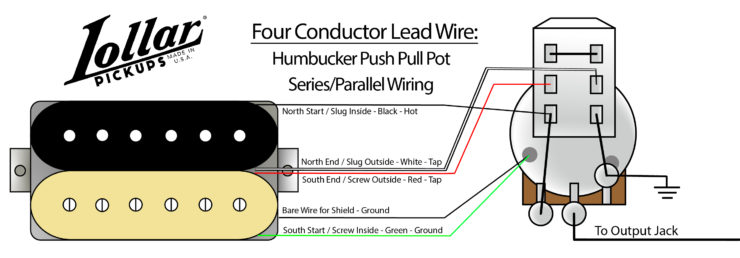
Typically, when we start researching and designing a new humbucker, we wire the pickups in the simplest and most common way possible: in series, with no coil tapping, phase switching, or parallel options. We want to hear the purest tone possible from the pickup in its essential form. Sometimes this takes many hours; sometimes it takes years.
Our dB humbucker was no exception. Years were spent in development. High gain pickups weren’t something we were well-known for making, so it was a new experiment to push ourselves into new territory. Our objective was a high gain pickup that wasn’t simply riding the coattails of active pickups or previous high output designs. Most importantly, it had to offer the same harmonically rich, three-dimensional tone, touch sensitivity, and dynamic response found in all our pickup designs.
The sound is very midrange forward with an output that pegs the inductance meter. The Super Reverb we have here at the shop to test new pickups is nearly impossible to break up due to the high headroom of the preamp, but the dB sent it into a roaring overdrive that was slightly scary the first time we heard it. It reminded us of Matt Pike’s guitar tone from “Dragonaut” from Sleep’s album Sleep’s Holy Mountain — just crushingly heavy! And through a Silverface Super Reverb no less — not typically the rig of choice for the heaviest of heavies. But it still sounded a bit too midrange-forward, with a slightly dampened top end that might have left some folks wanting for more clarity.
The “eureka!” moment came when — at the suggestion of former Lollar employee and High On Fire guitar tech Jordan Wagner — we tried it with a 1meg pot in lieu of a 500k. There was an immediate difference. The top-end opened further, and the midrange dominance eased up. The low end was meaty and huge, while remaining tight and percussive. The added bandwidth of the 1meg pot changed not only the frequency response but also the dynamic response. We had always felt that 500k pots are the sweet spot of bright/dark for typical humbuckers, but the dB is something different entirely.
Like many things about the dB, using a 1meg pot with it was a pleasant surprise that helped us find the sound we were seeking.
Coil splitting and series/parallel
Other than hum cancellation, another advantage of each pickup having two discrete coils is access to a variety of sounds like in/out of phase or coil splitting. One of the most common mods we get asked about is coil-tapping.
“What does a coil-split sound like with this *insert model* humbucker?”
Usually the higher the output, the better the split-coil sounds. But coil split is usually a compromise when compared to the full humbucking sound. Split coils don’t sound like a Strat, Tele, or other familiar single-coil. It sounds like exactly what it is: half of a humbucker. Many times, that sound will be weak and overly bright — not very useful for most players.
The dB, however, sounds amazing when split. It’s almost like our Staple P-90, but with a wider dynamic range — robust but clear, with a three-dimensional top end. And like most of our blade-pole designs, though 60-cycle hum is still present, it’s less noticeable than with other single-coil pickups.
But are those really where our options end? That question led me down another road: one that gave me the exact sound I wanted from a truly versatile pickup set.
Running the coils on each humbucker in parallel rather than series: My personal experience.
Originally, when I wired my Player Series Jazzmaster up with our dB humbuckers, I used 1 meg push/pull pots and added a coil tap function for each pickup. The pickups in full humbucking mode sound huge, but sometimes I want the reaction and sound of a single coil. I couldn’t believe how good our dB humbuckers sounded in single coil. The output remained, and there was an amazing frequency balance that sounded robust in the midrange but clear on the top end. I liked it so much that I ended up using it in single coil mode most of the time.
I thought about wiring only one side of the pickup and running a dummy coil in series with that coil. But that option would ultimately sound closer to the dB in full humbucking mode than the sound I was trying to achieve. Like many players, I wanted more of the single-coil character, but with less noise to save myself time when tracking, and to avoid using a noise gate when playing a venue with dirty power or other EMI/RFI issues.
So I thought, “What if I run the coils in parallel, instead of series, like a humbucker is normally wired? Would it drop the output slightly and add a little bit more top end with a more percussive low end like the single-coil?” It did exactly what I expected and hoped. It still sounded full and big-bodied, but the output dropped a bit and the midrange pulled back which opened the sound. There was also more top end available along with a tighter low end — closer to how the pickup reacts when splitting into single-coil form. More pick and tick to the sound than just a big roar. It exceeded my expectations so much that I’ve wired the pickups this way permanently.
[Personal anecdote: The dB sounds incredible in its traditional (full humbucker) form, operating in series. I want to make it clear that this was a quest for trying to get closer to an ideal sound that I knew was within the pickup for my personal playing style. I’ll touch more on this in my conclusion below.]
I can’t take full credit for my own discovery. We actually did try this initially with our dB when 500k pots were installed, but it wasn’t a big enough difference at the time. I believe the added bandwidth of the 1 meg pot is what allowed such a dramatic change and shift in sound. Possibly because the dB’s output is so hot, the 500k pot couldn’t match that bandwidth for enough of a change.
“So how do I wire this up to test?”
Our four-conductor color coding is as follows:
- Black – North start/slug inside – hot
- White – North end/slug outside- tap
- Red – South end/screw outside – tap
- Green – South start/screw inside – ground = attach to bare
- Bare – ground/shield
This wiring gives you the typical series wiring that a humbucker offers. Signal runs from one coil, into the other, then the combined signal of both coils exit through one hot wire; the black lead. You can think of your white and red taps for the coil ends allowing a signal to pass through one, into the other. Green attached to bare allows the signal to run to the common ground so that you have a completed circuit.
So, here’s how to wire the pickup to a selector switch or pot for parallel operation.

- Black – North start/slug inside – Hot – attached to Red
- Red – South end/screw outside – Hot – attached to Black
- White – North end/slug outside – attached to bare and Green – to Ground
- Green – South start/screw inside – attached to bare and White – to Ground
- Bare – ground/shield – attached to White and Green – to Ground
This wiring allows the signal from both coils to run in parallel to a switch independently from each other. This works like your two and four positions on a Strat. Black and red combined become your hot lead wire, and white with green connected to the bare shield wire becomes the end of your circuit that’s sent to ground. From here, you could also use toggles or push/pull pots for even more versatility.
You’ll need to dedicate one push/pull for the neck pickup, and one for the bridge pickup. Depending on your control layout that could be a push/pull for the neck and bridge volume pots, or a push/pull for the master volume connected to the neck, and another for the tone connected to the bridge pickup.
Here’s a general diagram with a Push-Pull pot for one pickup

Wiring up a master series/parallel pot won’t control the individual pickups. It will just change the interaction of the two humbuckers that are in series combination when combined (which is normally parallel).
Conclusion:
This example doesn’t specifically apply to just our dB set. You could use this with any of our four-conductor lead wire humbuckers.
Do you feel like your humbucker is a little too dark in your HSS set? Love our High Wind or Standard Wind Imperial set, but have a dark sounding neck position due to the guitar’s resonant frequencies? Do you want something a little brighter and closer to a single-coil sound, but with no added noise in the neck position of your Les Paul? Try the humbucker in parallel.
There are certain guidelines, but because of the subjective nature of tone and sound, there aren’t any definite rules in the pursuit of what sounds right for you.